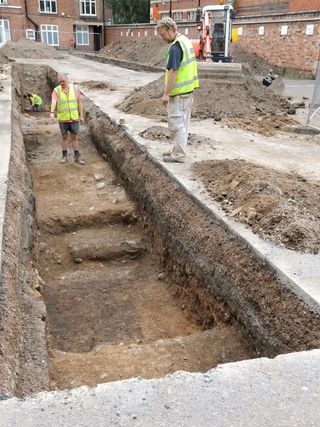Hints of King Richard III's Grave Found Under Parking Lot

The search for the long-lost remains of King Richard III in Leicester, England, has turned up traces of what may be the church where the slain monarch was buried.
Leicester University archaeologists announced today (Aug. 31) that their excavations in a city council parking lot have turned up medieval window tracery, glazed floor tile fragments and medieval roof tile. The high-quality materials suggest that the team is indeed digging around the Greyfriars church, where Richard III is said to be buried.
"Today, what we are saying is that we have found the Greyfriars and have uncovered tantalizing clues as to the location of the church," Richard Buckley, who co-directs the University of Leicester Archaeological Services, said in a statement. "It has gone about as well as we could hope for."
Richard III was King of England from 1483 to 1485. He died during the Battle of Bosworth Field during the War of the Roses, an English civil war between the House of Lancaster and the House of York. Richard III was the last English king to die in battle. Shakespeare penned "Richard III," a play about the tragic king, approximately 100 years later.

After his death, Richard III was buried at the Franciscan Friary in Leicester, known as Greyfriars. But the grave — and the church itself — was eventually forgotten. Interest in the infamous king meant various tales sprouted up about where his grave was located, with some far-fetched grave tales including the idea the bones were thrown into the river Soar. "Other fables, equally discredited, claimed that his coffin was used as a horse-trough," Philippa Langley, a Richard III Society member, said in a statement. [Gallery: Digging for King Richard III]
University of Leicester archaeologists suspected, in reality, that the Leicester City Council parking lot might cover the medieval site, and used ground-penetrating radar to pinpoint the best spots to dig.
In the first week of excavations, the team dug two 98-foot (30-meter) trenches and found what they believe may be segments of the Greyfriars cloisters walk and a section of church wall. They next plan to dig a trench that will intersect with the church itself.
Sign up for the Live Science daily newsletter now
Get the world’s most fascinating discoveries delivered straight to your inbox.
Finding Richard III's body is still a "long shot," Buckley said. If he is found, the dead king will be reinterred inside the Leicester Cathedral. If not, Buckley said, the excavation is still an exciting find.
"[T]he archaeological work we have done so far is revealing more about the archaeology of the Greyfriars area than we ever knew before," Buckley said. "In that respect, whatever the outcome — whether we find Richard or not — this work is an advance in terms of helping us tell the story of the city of Leicester."
The dig is the subject of a BBC Channel 4 documentary that will air later this year.
Follow Stephanie Pappas on Twitter @sipappas or LiveScience @livescience. We're also on Facebook & Google+.

Stephanie Pappas is a contributing writer for Live Science, covering topics ranging from geoscience to archaeology to the human brain and behavior. She was previously a senior writer for Live Science but is now a freelancer based in Denver, Colorado, and regularly contributes to Scientific American and The Monitor, the monthly magazine of the American Psychological Association. Stephanie received a bachelor's degree in psychology from the University of South Carolina and a graduate certificate in science communication from the University of California, Santa Cruz.










